Mobile industrial robots
Mobile industrial robots are pieces of machinery that are able to be programmed to perform tasks in an industrial setting. Typically these have been used in stationary and workbench applications; however, mobile industrial robots introduce a new method for lean manufacturing. With advances in controls and robotics, current technology has been improved allowing for mobile tasks such as product delivery. This additional flexibility in manufacturing can save a company time and money during the manufacturing process, and therefore results in a cheaper end product.
Mobile robot technology has potential to revolutionize many sectors of industry; however, it carries with it some disadvantages. The logistics of manufacturing will be streamlined by allowing robots to autonomously navigate to different areas for their work. The labour demands for employees will be lessened as robots will be able to work alongside humans, and robots will assist with medicine and surgery more and more. However, there are drawbacks to this technology. Coordinating the movement of robots around facilities and calibrating their position at their destination is tedious and far from perfect.[1] A robot malfunctioning in a manufacturing setting will hold up production - and this robot could malfunction anywhere in a facility. Human safety must also be considered. Robots must prioritize the safety of human operators over their programmed task - which may complicate the coordination of multiple autonomous robots. Especially in a surgical setting, there is no room for error on the robot's part. Even though some challenges are present, mobile robot technology promises to streamline aspects across much of the industry.[2]
History
Automation began in the automobile industry in the years surrounding WWII (1946) and the origin of the term itself belongs with D.S. Harder, the engineering manager at the Ford Motor Company. At first, the term was used to describe the increased presence of automatic devices in production lines and solely manufacturing contexts. Now, automation is widely used in many industries where computerized action and feedback loops can replace human intervention in the workplace. Over time, development in this area has become increasingly dependent upon advanced computer technologies and the advancement of processing capabilities.[3]
In its current form, most industrial robots are powered mechanical arms with the ability to perform anthropomorphic actions. Advancements in miniaturization of computers, mathematical control theory as well as improved sensory technologies have had great impact on the feedback control systems that drive robotics.[3] The first industrial robot performed spot welding and die castings in a General Motors factory in New Jersey, USA in 1962. Soon, robotic arms were exploding within the large-scale manufacturing industry and several new companies came into existence including Kuka in 1973, Nachi in 1969, Fanuc in 1974, Yaskawa in 1977, ASEA in 1977, and several others. By 1980, it is estimated a new major robotics company entered the market every month.[4]
Mobile robotics are now set to experience similar expansion as they become significantly more reliable in an industrial setting. Even if a mobile robot makes mistakes, it will eventually be less frequently than mistakes caused by human factors.
Overview
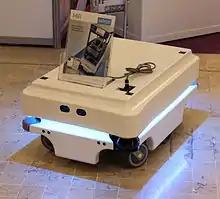
The simplicity of mobile industrial robots provide their main advantage in industrial settings due to the ease of use and ability to be operated via technologies well understood by most people. In addition, robots are able to operate almost continuously and will never complain about long work hours; greatly increasing efficiency in a lean manufacturing environment. The main current disadvantage lies in high costs of repair as well as the production delays that would be caused by a failure or malfunction. These factors are very preventative to putting major amounts of responsibility on mobile robotics, however they are being continually lessened.[1][5]
Applications of mobile industrial robots
The mobile industrial robots have many applications that they have been used in already including in the healthcare industry, home and industrial security, ocean and space exploration, the food service industry, and in distribution applications.
Medicine
Mobile industrial robots have several uses within the healthcare industry in both hospitals and homes. Drug delivery, patient services, and other nursing functions could be easily adapted to robots. Due to the fact that items being carried around typically weigh less than 100 kg, robots much smaller than the MiR (see above) may be used. Specialized equipment may be mounted on robots, allowing them to assist with surgical procedures. Overall, their place in the medical industry is to provide a more reliable source of customer care while reducing human error.[5]
Scientific experimentation and exploration
In the scientific world, there is a large number of applications for mobile robots. Their ability to perform experiments and exploration without putting human lives in danger makes them an important asset. Unlike humans, robots do not require life support systems to function. In space travel, robots are performing science on planets and asteroids because sending humans is far more taxing on resources and money. The same is true in the oceanography domain. In fact, several of the same robotic systems are designed to perform their science under both conditions - space and underwater. In nuclear power plants, robots can service electronics and mechanical systems which prevents human exposure to large amounts of radiation.[5]
Aircraft maintenance and repair

For applications like painting and de-painting aircraft, two fixed robots are inadequate because not all parts of the aircraft can be reached. Adding more fixed robots would complete the task, but the cost is prohibitive. If mobile robots are used, one or two may be enough to service the entire aircraft because they can move to whatever area needs work. Mobile robots need to be truly autonomous to be useful in manufacturing. Erik Nieves said, “Mobility moves robots from being machines to production partners” Rather than bringing work to the robot, the robot should be smart enough to go to where the work is.[5]
Automated aircraft inspection systems have the potential to make aircraft maintenance safer and more reliable.[6] Various solutions are currently developed: a collaborative mobile robot named Air-Cobot,[7][8][9] and autonomous drones from Donecle or EasyJet.[10][11]
Pipeline maintenance
For maintenance of pipelines which are buried underground, mobile robots can travel through the pipeline performing inspection and maintenance operations, replacing other techniques, some of which could only otherwise be done by unearthing the pipeline. CISBOT (cast-iron sealing robot) a cast iron pipe repair robot that seals the joints in natural gas pipelines from the inside.[12]
Examples
OTTO Motors (a division of Clearpath)[13]
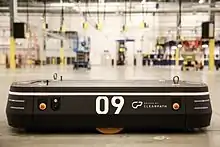
Meant for material transport in industrial centers
- Able to carry 100 kg (OTTO 100) or 1500 kg (OTTO 1500)
- Powered by lithium battery technology
- 6–8 hours operating time (depending on payload)
- Requires no structural changes to building
- Navigates via 2D sensors. Proprietary autonomy software enables dynamic path-planning and obstacle avoidance at speeds matching forklifts (2 m/s).
- Used by GE and John Deere.[14][15]
MiR (Mobile Industrial Robots A/S.)
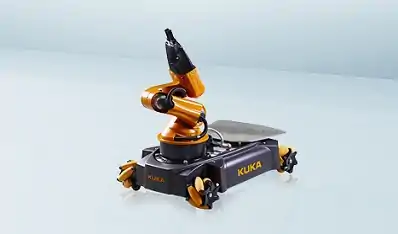
https://www.mobile-industrial-robots.com/en/
- Meant for transportation
- Depend on model can carry 100kg, 200kg, 250kg, 500kg and 1000kg large enough to hold full size EU pallet or American
- Electrically powered by lithium battery technology
- Long operating time on a single battery charge (8-10 hours/20 km)
- Maximum velocity: 2.0 m/s
- Requires no structural changes of building (i.e. wires in the floor, sensors in the ceiling)
- Can be operated via smartphone or PC, via WiFi
- Navigates via an array of 2D and 3D scanners and cameras[16][17]
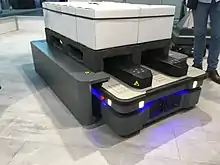
Kuka
- Very widely used—Example: Tesla Motors [18]
- "Mecanum" wheel system: customizeable, modular, heavy-lifting capable
- Very easy to integrate with autonomous robotics and humans[2][19]
Waypoint Robotics, Inc.
https://www.waypointrobotics.com
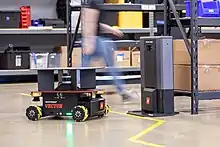
- Industrial-strength and ideal for both manufacturing and warehouse applications[20]
- Up to 600 lb (Vector[21] & 3000 lb (MAV3K[22] capacity models available
- Easy to set up, fast to deploy, and designed to be used by workers on the job today
- Omnidirectional mobility enables movement in any direction and in any orientation with speed and accuracy
- Employs 2D safety rated lidar sensors with option for 3D lidar
- Superior mapping and unrivalled navigation made possible by high speed, real time, sensor fusion within Waypoint’s proprietary robot controller
References
- Zhang, Biao; Martinez, C.; Wang, Jianjun; Fuhlbrigge, T.; Eakins, W.; Chen, Heping (2010-08-01). "The challenges of integrating an industrial robot on a mobile platform". 2010 IEEE International Conference on Automation and Logistics (ICAL): 255–260. doi:10.1109/ICAL.2010.5585289. ISBN 978-1-4244-8375-4.
- "Why Should we use Autonomous Industrial Mobile Manipulators - Smashing Robotics". Smashing Robotics. Retrieved 2016-03-16.
- "automation". Encyclopædia Britannica. Retrieved 2016-03-16.
- "Industrial Robot History". www.robots.com. Archived from the original on 2015-07-08. Retrieved 2016-03-16.
- "Robotics Online". Robotics Online. Retrieved 2016-03-16.
- "Robots in the hangar". Flight Safety Australia. November 23, 2015. Retrieved May 20, 2016.
- "Air-Cobot". Archived from the original on July 12, 2016. Retrieved May 20, 2016.
- Jovancevic, Igor; Larnier, Stanislas; Orteu, Jean-José; Sentenac, Thierry (November 2015). "Automated exterior inspection of an aircraft with a pan-tilt-zoom camera mounted on a mobile robot" (PDF). Journal of Electronic Imaging. 24 (6): 061110. Bibcode:2015JEI....24f1110J. doi:10.1117/1.JEI.24.6.061110.
- I. Jovancevic, I. Viana, T. Sentenac, J.J. Orteu and S. Larnier, Matching CAD model and images features for robot navigation and inspection of an aircraft, International Conference on Pattern Recognition Applications and Methods, pp. 359-366, February 2016.
- "Donecle - lightning fast aircraft inspections". Retrieved May 20, 2016.
- Golson, Jordan (June 10, 2015). "EasyJet's Using Drones to Check Planes for Lightning Damage". Wired. Retrieved May 20, 2016.
- Barron, James (December 28, 2017). "21st-Century Repairman: The Robot in the Gas Main". New York Times. Retrieved February 26, 2018.
- "OTTO Motors". Retrieved August 8, 2016.
- "Clearpath to Provide GE Healthcare Repair Center with Self-Driving Vehicles". Retrieved August 9, 2016.
- "Clearpath Joins John Deere Supply Base". February 23, 2016.
- "Mobile Industrial Robots | Robot til transportopgaver i industrien og i sundhedssektoren". mobile-industrial-robots.com. Retrieved 2016-03-16.
- Mobile Industrial Robots ApS (2014-12-10), MiR at Hannover 2014, retrieved 2016-03-16
- "Tesla Has An Army Of Kuka Robots Waiting To Be Installed On Model 3 Assembly Line". CleanTechnica. 2017-04-27. Retrieved 2021-01-20.
- "KUKA Industrial Robots - Mobility". www.kuka-robotics.com. Retrieved 2016-03-16.
- "AMRs for industrial applications". Waypoint Robotics. Retrieved 30 July 2020.
- "Vector 600 lb capacity autonomous mobile robot". Waypoint Robotics. Retrieved 30 July 2020.
- "MAV3K 3000 lb capacity autonomous mobile robot". Waypoint Robotics. Retrieved 30 July 2020.